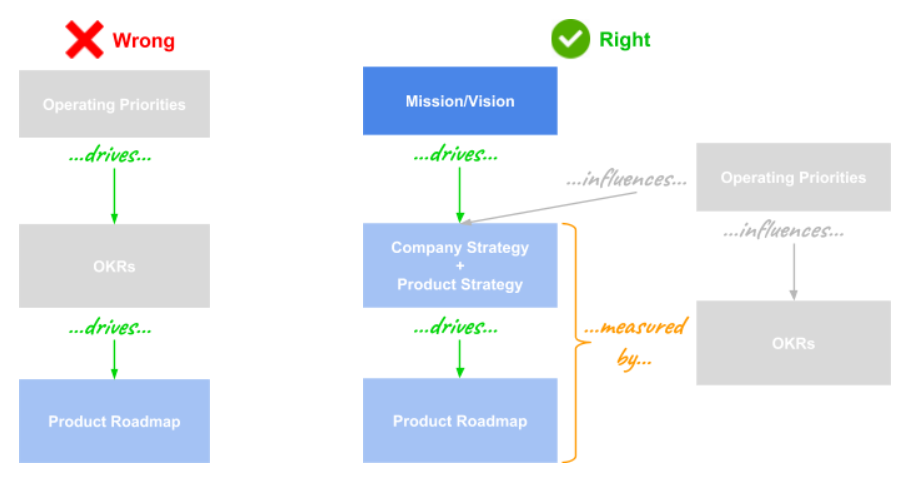- Another PM Day
- Posts
- A Practical Guide to Using OKRs in B2B Product Management
A Practical Guide to Using OKRs in B2B Product Management

A Practical Guide to Using OKRs for Product Managers
Why does it matter?
When I started my PM career 15 years ago, I underestimated the power of OKRs (Objectives and Key Results) that are a practical framework that can greatly benefit Product Management teams. I was mistaken, what I have realized with time is that they provide a clear and structured way to set goals, define milestones, and measure progress.
The importance of using OKRs in Product Management lies in their ability to focus on priorities. By setting objectives that align with the product strategy, teams can ensure that their efforts are directed towards the most important goals. This helps prevent wasted resources and ensures that everyone is working towards a common product vision.
OKRs…but why??
OKRs (Objectives and Key Results) provide a valuable framework for B2B Product Management teams by prioritizing objectives, translating strategy into actionable goals, and boosting team morale.
Key Learning
💡 Prioritize objectives in line with product strategy to prevent wasted resources and ensure alignment towards a common product vision.
📈 Translate Product Strategy into actionable and measurable goals by breaking down high-level objectives into key results and tracking progress.
👥 Boost team morale by increasing motivation and creating a sense of accomplishment through understanding roles and seeing progress.
🔄 Cascade OKRs to align individual and team objectives with broader company goals.
📋 Visualize OKRs using Kanban boards to track progress and identify bottlenecks.
🎯 Create stage-specific goals for different product development stages to have focused objectives and key results.
What makes OKRs different from Product Strategy?
OKRs (Objectives and Key Results) and Product Strategy are distinct yet interconnected components of effective product management, with OKRs focusing on execution and short-term goals, while Product Strategy outlines broader efforts for long-term vision.
Key Learning
🚀 OKRs primarily focus on execution and tactical goals, providing clear targets and metrics to track progress and drive action.
🌟 Product Strategy lays out the overall direction and vision for the product, defining market positioning, target customer segments, and competitive landscape.
🔄 OKRs and Product Strategy are interconnected, with OKRs influencing and being influenced by the Product Strategy, allowing for adaptation and alignment with market and user needs.
The WHY behind the OKR purpose
Starting with the WHY behind using OKRs in Product Management is of utmost importance. It sets the foundation and purpose for implementing OKRs within an organization. By clearly defining the desired outcomes and objectives, teams can align their efforts and actions towards achieving those goals.
Starting with the WHY behind using OKRs in Product Management is crucial as it lays the foundation, aligns efforts, and provides a clear vision for achieving desired outcomes.
Types of OKRs?
The implementation of Objectives and Key Results (OKRs) in Product Management can bring numerous benefits to organizations. However, it's essential to understand how OKRs can be effectively utilized and applied in this context. In this section, we will explore some examples of how Product Management teams can use OKRs to drive their strategies and achieve their objectives.
1. Increasing User Engagement: One of the primary goals for Product Management is to enhance user engagement with the product. By setting an objective to increase user engagement metrics, such as daily active B2B or B2C users or time spent on the platform, B2B Product Managers can then establish key results to measure progress, such as a certain percentage increase in user retention or a specific improvement in user satisfaction scores.
2. Improving Conversion Rates: Another important area for Product Management is optimizing conversion rates. By setting an objective to improve conversion rates, B2B Product Managers can set key results related to increasing click-through rates, reducing bounce rates, or improving the overall user onboarding experience.
3. Launching New Features: Product Management teams often strive to deliver innovative features to the market. Setting an objective to launch new features can then be supported by key results like delivering a specified number of product releases within a certain timeframe or achieving a specific level of customer adoption for new features.
4. Expanding into New Markets: Product Managers may also have objectives related to expanding into new markets or target customer segments. Key results for this objective could include achieving a certain level of market penetration in the new market, securing a set number of new enterprise customers, or achieving a specific revenue target from the new market segment.
By setting clear objectives and defining measurable key results, Product Development teams can align their efforts and drive successful outcomes for their organizations. Moreover, it allows them to track their progress and adapt their strategies accordingly.


Reply